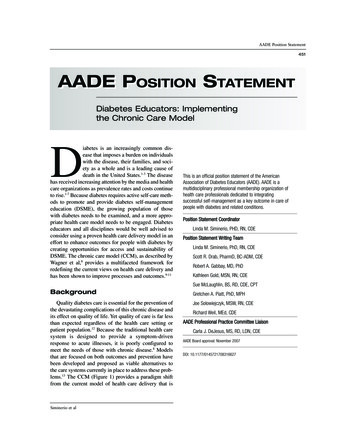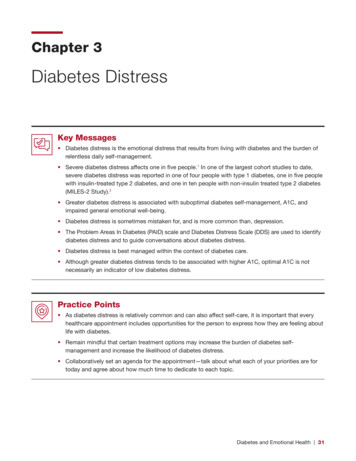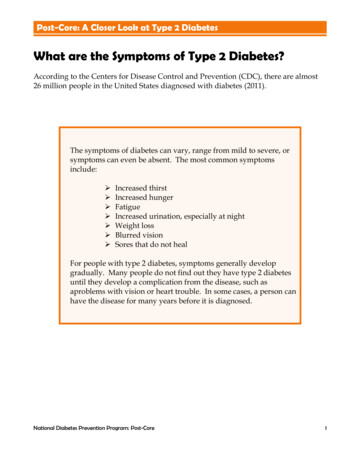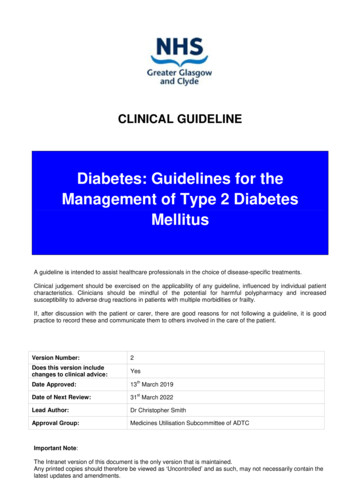
Transcription
TDE316627 For WEB.qxd5/20/20086:52 PMPage 451AADE Position Statement451AADE POSITIONOSITION STATEMENTTATEMENTDiabetes Educators: Implementingthe Chronic Care ModelDiabetes is an increasingly common disease that imposes a burden on individualswith the disease, their families, and society as a whole and is a leading cause ofdeath in the United States.1-3 The diseasehas received increasing attention by the media and healthcare organizations as prevalence rates and costs continueto rise.1-7 Because diabetes requires active self-care methods to promote and provide diabetes self-managementeducation (DSME), the growing population of thosewith diabetes needs to be examined, and a more appropriate health care model needs to be engaged. Diabeteseducators and all disciplines would be well advised toconsider using a proven health care delivery model in aneffort to enhance outcomes for people with diabetes bycreating opportunities for access and sustainability ofDSME. The chronic care model (CCM), as described byWagner et al,8 provides a multifaceted framework forredefining the current views on health care delivery andhas been shown to improve processes and outcomes.9-11This is an official position statement of the AmericanAssociation of Diabetes Educators (AADE). AADE is amultidisciplinary professional membership organization ofhealth care professionals dedicated to integratingsuccessful self-management as a key outcome in care ofpeople with diabetes and related conditions.Position Statement CoordinatorLinda M. Siminerio, PHD, RN, CDEPosition Statement Writing TeamLinda M. Siminerio, PhD, RN, CDEScott R. Drab, PharmD, BC-ADM, CDERobert A. Gabbay, MD, PhDKathleen Gold, MSN, RN, CDESue McLaughlin, BS, RD, CDE, CPTBackgroundGretchen A. Piatt, PhD, MPHQuality diabetes care is essential for the prevention ofthe devastating complications of this chronic disease andits effect on quality of life. Yet quality of care is far lessthan expected regardless of the health care setting orpatient population.12 Because the traditional health caresystem is designed to provide a symptom-drivenresponse to acute illnesses, it is poorly configured tomeet the needs of those with chronic disease.8 Modelsthat are focused on both outcomes and prevention havebeen developed and proposed as viable alternatives tothe care systems currently in place to address these problems.13 The CCM (Figure 1) provides a paradigm shiftfrom the current model of health care delivery that isJoe Solowiejczyk, MSW, RN, CDESiminerio et alRichard Weil, MEd, CDEAADE Professional Practice Committee LiaisonCarla J. DeJesus, MS, RD, LDN, CDEAADE Board approval: November 2007DOI: 10.1177/0145721708316627
TDE316627 For WEB.qxd5/20/20086:52 PMPage 452The Diabetes EDUCATOR452and successfully self-manage the disease and its relatedconditions. DSMT/DSME is an interactive, ongoingprocess involving the person with diabetes (or the caregiver or family) and a diabetes educator(s). The intervention aims to achieve optimal health status, achieve a betterquality of life, and reduce the need for costly health care.Diabetes education focuses on 7 self-care behaviorsthat are essential for improved health status and greaterquality of life. The AADE7 Self-Care Behaviors arehealthy eating, being active, monitoring, taking medication, problem solving, healthy coping, and reducingrisks. The Wagner CCM identifies key elements that arecritical to success.Figure 1. The care model.designed to handle acute problems to a system that isprevention based and focused on avoiding long-termproblems, including diabetes complications.8 The premise of the model is that quality care is not delivered inisolation but (1) interfaces with the community andits resources, (2) includes self-management support,(3) shifts how care is delivered within the health caresystem, (4) is based on decision support and evidence,(5) is driven by clinical information systems, and (6) isoffered in settings and/or organizations that valuechronic care. The result of this shift in the locus of careis a productive interaction between a proactive practiceteam and prepared activated person with diabetes thatdrives clinical and functional improvement.8,13 OtherCCMs such as the ecological model incorporate otherconcepts but may be applicable for only certain situations and populations.14,15The CCM refined by Wagner is a construct that provides a long-term management approach. Wagner’sCCM answers the need to have a systematic, comprehensive system of care that serves the needs of bothpatients and providers.16,17 This CCM indicates thatDSME can occur in relation to different parts of thehealth care system encompassed by the CCM, includingprimary care settings. Table 1 provides examples andrecommendations for diabetes educators who are usingthe CCM framework.Diabetes education, also known as diabetes selfmanagement training (DSMT) or DSME, is a collaborativeprocess through which people with, or at risk for, diabetesgain the knowledge and skills needed to modify behaviorElements1. Health care organization/organization of healthcare. This element provides the structural foundation(philosophically and literally) on which the remaining 4components of the CCM rely (Figure 1). Understandingthe mission, goals, and values of the provider organization and its relationship with purchasers, insurers, andhealth care providers is the key to successful CCMimplementation. It is doubtful that meaningful improvement in chronic disease care can be achieved withoutcommitted leadership and resources.182. Community resources and policies. Communitiesprovide individuals with diabetes, their caregivers,friends, and employers with a variety of ancillary services that provide support for diabetes self-management.Policies define relationships within a communitybetween various agencies (eg, networks, how servicesare accessed and provided, etc). Policies are also important for reimbursement and sustainability.3. Decision support. Decision support uses specialistexpertise to establish evidence-based clinical practiceguidelines, standards, and protocols. Use of these evidencebased tools can be facilitated through provider educationand support programs.4. Self-management support. This element engagesthe patient in the active self-management of his or her illness. When informed patients take an active role in managing their disease and providers are prepared, proactive,and supported with time and resources, their interactionis likely to be productive.11 The goal is to customize careVolume 34, Number 3, May/June 2008
TDE316627 For WEB.qxd5/20/20086:52 PMPage 453AADE Position Statement453Table 1Examples/Recommendations for Diabetes Education Applications Using the Chronic Care Model FrameworkHealth systemLay out master planEngage key stakeholdersEstablish objectives and a mission statementWork with leadershipPresent outcomes of diabetes self-management education (DSME) interventions to administration, board of directors, and stakeholdersCommunityAssess target populationsImplement surveys, town hall meetings, and focus groupsIdentify community sitesWork with community partners in churches, wellness sites, schoolsPartner with insurers, government agencies, policy makersDecision supportIdentify and implement guidelines, standards, algorithms, and protocolsOrganize training for health care providersClinical information systemsImplement a registry that evaluates the delivery of care across patient populations; ensure DSME services and SMSdocumentation are integrated into the primary care information systemSelf-managementExplore every opportunity to engage person with diabetes in the provision of self-careImplement strategies to support behavior changeSystem redesignExplore the provision of DSME in primary care, libraries, pharmacies, and community centersEngage new partners and approaches for DSME support such as community workers, office staff, and telephonic and computer systemsto engage the patient in setting goals that change theirbehavior to self-manage their diabetes.195. Clinical information systems. These systems arenecessary for collecting and housing timely, useful dataabout individual patients and populations of patients,using tools such as patient registries and care reminders.The information system allows quality measures to beassessed and care evaluated, providing ongoing feedbackto the provider and patient.6. Delivery system design. This element defines teamroles and delegates tasks. Planned management ensurescontinuity of care and regular follow-up throughredesigning how care is delivered.Siminerio et alCCM ParadigmBecause of its multifaceted nature, quality diabetescare requires an integration of the patient into a healthsystem that promotes long-term management,14,20 ratherthan a system in which care is provided episodically.Unlike acute illnesses, diabetes encompasses behavioral,psychosocial, psychological, environmental, and clinicalfactors, all of which require team-based support from avariety of health care disciplines.21-24 The implementation of the CCM creates this shift to continuity of careand long-term self-management.An integral facet of the CCM is the importance ofself-management support. A growing body of evidence demonstrates that interventions that foster patient
TDE316627 For WEB.qxd5/20/20086:52 PMPage 454The Diabetes EDUCATOR454self-management behaviors improve health status andlower health care costs in chronic disease.19,20,25 DSME iscritical in laying the foundation for promoting theknowledge and skills necessary for patients with diabetesto appropriately perform and manage self-care tasks.DSME is now widely considered to be an important partof diabetes management.26,27 Healthy People 2010 aimedto increase the number of people who receive diabeteseducation from 40% (1998) to 60% (2010).28 However,the number of individuals who receive diabetes education is disappointingly small (unpublished AADE analysis of Centers for Medicare & Medicaid Services 2005and 2006 data).29,30 Progress is, however, being made inmeeting that goal.31Access to education has been identified as a potentialbarrier, particularly in communities where the closestDSME program may be miles away.32 Another potentialproblem may be the traditional way in which educationis prescribed and delivered. In many areas, physiciansare encouraged by their affiliated institutions to referpatients with diabetes to a centralized hospital-basedDSME program. This process is consistent with the current system of health care delivery as it applies to acutecare where services are provided at a hospital. Althoughmore than 90% of patients with diabetes are cared for byprimary care physicians),33 education is rarely availablein the primary care office.34,35 Efforts to deploy qualityeducation in community sites that include primary carepractices need to be explored.Another challenge for the provision of DSME is sustainability of program services. In a survey of educatorsconducted by the American Association of DiabetesEducators (AADE) and American Diabetes Association(ADA), educators reported program closings andexpressed frustration with the implementation ofMedicare benefits.36 Inadequate reimbursement for services provided (by Medicare and others) has led to theclosure of DSME programs, as organizations seek to cutexpenses when financial stability cannot be demonstrated.37 Findings from this survey confirmed otherstudy results indicating that diabetes education is anunderused service36 and that reimbursement practiceswere poor. Both the AADE and ADA have concludedthat adoption of a systems approach specific to DSME iscritically important and much needed.36The CCM has already been shown to be an effective means of implementing and sustaining DSMEprograms10,32,38 because it emphasizes self-management,provides an ideal framework for a systematic approach,and supports the inclusion of all members of the diabeteshealth care team in contrast to traditional methods. Themodel can help increase access to DSME for morepatients. The CCM is also gaining momentum as asystems-based response to chronic disease care and canbe applied in most any setting, ranging from communitybased programs to inpatient facilities. Several health careorganizations38 and state governmental organizations andprofessional associations are currently looking at modeling care around a CCM. As the incidence of diabetescontinues to increase at rapid pace, systematic approachesneed to be established so that DSME may be accessibleto the ever-increasing pool of people with diabetes.Leveraging an increased interest in the CCM (to furtherfoster DSME in the current health care environment)may help to provide new avenues of support for appropriate reimbursement and dissemination of this evidencebased approach.RecommendationsFirst and foremost, educators need to expand opportunities for changing practice and be open to change. TheCCM provides a template for diabetes educators toexplore collaboration with multiple stakeholders in theirlocal health care systems and communities. Potentialpartners include organization administrators, financialofficers, information systems, insurers, employers, andpolicy makers. This template leads to searches for opportunities outside of traditional educator roles, such as thedevelopment of business models for sustainability,strategic planning, and integrating technologicalapproaches and data management. The model also challenges diabetes educators to develop partnerships with community facilities such aswellness and senior centers, seek opportunities to collect and share outcomes data ondiabetes education, overlap responsibilities with other team members, and form consortia and/or organize systemwide quality initiatives.ConclusionsDiabetes is a serious disease that requires a personto make daily decisions about his or her self-care. ToVolume 34, Number 3, May/June 2008
TDE316627 For WEB.qxd5/20/20086:52 PMPage 455AADE Position Statement455promote good health, the person with diabetes needs tobe proficient in key self-care behaviors that includethemes such as the AADE7 Self-Care Behaviors: eatinghealthy, being active, monitoring, taking medication,problem solving, healthy coping, and reducing risk.39-45Provision of DSME is critical in laying the foundationthat promotes knowledge, skills, and self-care behaviorchange strategies. To increase the number of people whoreceive DSME, a comprehensive, systematic approach isnecessary. The CCM provides an ideal framework tosupport DSME because it provides a cogent basis onwhich to promote self-management based on theAADE7 framework.Developing systems that promote accessible, sustainable DSME services that affect health outcomes has largescale public health implications. Organizing efforts tosupport the facilitation of DSME is critical if we expect tomeet the Healthy People 2010 education objectives.References1.Diabetes: Disabling Disease to Double by 2050. At a Glance.Centers for Disease Control and Prevention, Department ofHealth and Human Services Web site. m.2. Centers for Disease Control and Prevention. Prevalence of diabetes. In: National Diabetes Surveillance System. Atlanta, GA:Centers for Disease Control and Prevention; 2005.3. Cowie CC, Rust KF, Byrd-Holt DD, et al. Prevalence of diabetesand impaired fasting glucose in adults in the U.S. population:National Health and Nutrition Examination Survey 1999-2002.Diabetes Care. 2006;29:1263-1268.4. Vinicor F, Rufo K, Murphy D. Diabetes and public health in theUnited States. In: De Fronzo RA, Ferrannini E, Keen H, Zimmet P,eds. International Textbook of Diabetes Mellitus. 3rd ed. Chichester,UK: John Wiley & Sons; 2004:1785-1792.5. Amos AF, McCarty DJ, Zimmet P, et al. The rising global burdenof diabetes and its complications: estimates and projections to theyear 2010. Diabet Med. 1997;14:S1-S85.6. Rubin RR, Altman WM, Mendelson DN. Health care expenditures for people with diabetes mellitus. J Clin Endocrinol Metab.1994;78(4):809A.7. American Diabetes Association. Economic costs of diabetes inthe U.S. in 2002. Diabetes Care. 2003;26;917-932.8. Wagner EH, Austin BT, Von Korff M. Organizing care forpatients with chronic illness. Milbank Q. 1996;74:511-544.9. Wagner EH, Glasgow RE, Davis C, et al. Quality improvement inchronic illness care: a collaborative approach. Jt Comm J QualImprov. 2001;27(2):63-80.10. Siminerio L, Zgibor J, Solano FX Jr. Implementing the chroniccare model for improvements in diabetes practice and outcomesin primary care: the University of Pittsburgh Medical Centerexperience. Clin Diabet. 2004;22(2):54-58.Siminerio et al11. Bodenheimer T, Wagner EH, Grumbach K. Improving primarycare for patients with chronic illness: the chronic care model, part2. JAMA. 2002;288(15):1909-1914.12. Saadine JB, Engelgau MM, Beckles GL, Gregg EW, ThompsonTJ, Venkat Narayan KM. A diabetes report card for the UnitedStates: quality of care in the 1990’s. Ann Intern Med. 2002;136(8):565-574.13. Wagner EH, Austin BT, Von Korff M. Improving outcomes inchronic illness. Manag Care Q. 1996;4(2):12-25.14. Funnell MM, Peyrot MF, Rubin RR, Siminerio LM, eds. Steeringtoward a new DAWN in diabetes management. Diabetes Educ.Supplement for Continuing Education; 2005.15. Fischer DB, Walker EA, Bostrum A, Fischhoff B, Haire-Joshu E,Bennett Johnson S. Behavioral science research in the preventionof diabetes. Diabetes Care. 2002;25:599-606.16. Etzwiler DD. Chronic care: a need in search of a system. DiabetesEduc. 1997;23:569-573.17. Roman SH, Harris MI. Management of diabetes mellitus from apublic health perspective. Endocrinol Metab Clin North Am.1997;26:443-474.18. O’Connor J, Sperl-Hillen JM, Pronk NP, Murray T. Primary careclinic-based chronic disease care. Dis Manag Health Outcomes.2001;9:691-698.19. Committee on Quality of Health Care in America. Crossing theQuality Chasm: A New Health System for the 21st Century.Washington, DC: Institute of Medicine; 2001.20. Anderson RM, Funnell MM, Butler PM, Arnold MS, FitzgeraldJT, Feste CC. Patient empowerment: results of a randomized control trial. Diabetes Care. 1995;18:943-949.21. Wagner EH, Austin BT, Von Korff M. Organizing care forpatients with chronic illness. Milbank Q. 1996;74:511-544.22. Wagner E. The role of patient care teams in chronic disease management. Br Med J. 2000;320:569-572.23. Peyrot M, Rubin RR, Lauritzen T, Snoek F, Matthews D, Skovlund S;on behalf of the International DAWN Advisory Panel. Psychosocialproblems and barriers to improved diabetes management: results ofthe cross-national Diabetes Attitudes, Wishes and Needs (DAWN)study. Diabet Med. 2005;22:1379-1385.24. Skovlund SE, Peyrot M; DAWN International Advisory Panel.Lifestyle and behavior: the Diabetes Attitudes, Wishes and Needs(DAWN) program: a new approach to improving outcomes ofdiabetes care. Diabetes Spectrum. 2005;18:136-142.25. Glasgow RE, La Chance PA, Toobert DJ, Brown J, Hampson SE,Riddle MC. Long-term effects and costs of brief behaviouraldietary intervention for patients with diabetes delivered from themedical office. Patient Educ Couns. 1997;32(3):175-184.26. Norris SL, Engelgau MM, Narayan KMV. Effectiveness ofself-management training type 2 diabetes: a systematic reviewof randomized controlled trials. Diabetes Care. 2001;24:561-587.27. Brown SA. Effects of educational interventions and outcomes indiabetic adults: a meta-analysis revisited. Patient Educ Couns.1990;16:189-215.28. US Department of Health and Human Services. Healthy People2010: Understanding and Improving Health. Washington, DC:US Department of Health and Human Services, GovernmentPrinting Office; 2000.
TDE316627 For WEB.qxd5/20/20086:52 PMPage 456The Diabetes EDUCATOR45629. Coonrod BA, Betschart J, Harris MI. Frequency and determinantsof diabetes patient education among adults in the U.S. population.Diabetes Care. 1994;17:852-858.30. Hiss RG, Anderson RN, Hess GE, Stepien CJ, Davis WK.Community diabetes care: a 10-year perspective. Diabetes Care.1994;17:1124-1134.31. Centers for Disease Control and Prevention. Self-monitoring ofblood glucose among adults with diabetes—United States, 19972006. MMWR Morb Mortal Wkly Rep. 2007;56(43):1133-1137.32. Siminerio LM, Piatt G, Zgibor JC. Implementing the chronic caremodel for improvements in diabetes care and education in a ruralprimary care practice. Diabetes Educ. 2005;31:225-234.33. Janes GR. Ambulatory medical care for diabetes. In: GroupNDD, ed. Diabetes in America. Vol 95-1468. Bethesda, MD:National Institutes of Health; 1995:541-552.34. Glasgow R, Eakin E. Medical-office based interventions. In:Snoek F, Skinner C, eds. Psychology in Diabetes Care. New York,NY: Wiley and Sons, 2000; 141-168.35. Piette JD, Glasgow R. Strategies for improving behavioral healthoutcomes among patients with diabetes: self-management education. In Gerstein HC, Haynes RB, eds. Evidence-Based DiabetesCare. Ontario, Canada: BC Decker; 2001:207-251.36. Pearson J, Mensing C, Anderson R. Medicare reimbursement anddiabetes self-management training: national survey results.Diabetes Educ. 2004;30:914-927.37. Siminerio LM, Piatt GA, Emerson S, et al. Deploying the chroniccare model to implement and sustain diabetes self-managementtraining programs. Diabetes Educ. 2006;32:253-260.38. Siminerio L, Zgibor J, Solano FX Jr. Implementing the chroniccare model for improvements in diabetes practice and outcomesin primary care: the University of Pittsburgh Medical Centerexperience. Clin Diabetes. 2004;22(2):54-58.39. Peeples M, Mulcahy K, Tomky D, Weaver T. The conceptualframework of the National Diabetes Education Outcomes System(NDEOS). Diabetes Educ. 2001;27(4):547-562.40. Mulcahy K, Peeples MM, Tomky DM, Weaver TW. NationalDiabetes Education Outcomes System (NDEOS): application topractice. Diabetes Educ. 2000;26(6):957-964.41. Mulcahy K, Maryniuk M, Peeples M, et al. Diabetes selfmanagement education core outcome measures. Diabetes Educ.2003;29:768-803.42. Peeples M, Tomky D, Mulcahy K, Peyrot M, Siminerio L. Evolutionof the American Association of Diabetes Educators’ DiabetesEducation Outcomes Project. Diabetes Educ. 2007;33(5):794-817.43. Charron-Prochownik D, Zgibor J, Peyrot M, et al. The DiabetesSelf-Management Assessment Report Tool (D-SMART );process evaluation and patient satisfaction. Diabetes Educ. 2007;33(5):833-835.44. Zgibor J, Peyrot M, Ruppert K, et al. Using the AmericanAssociation of Diabetes Educator Outcomes System to identifypatient behavior change goals and diabetes educator responses.Diabetes Educ. 2007;33(5):839-842.45. Peyrot M, Peeples M, Tomky D, Charron-Prochownik D, Weaver T.Development of the American Association of Diabetes Educators’diabetes self-management assessment report tool. Diabetes Educ.2007;33(5):818-826.Volume 34, Number 3, May/June 2008
Joe Solowiejczyk, MSW, RN, CDE Richard Weil, MEd, CDE AADE Professional Practice Committee Liaison Carla J. DeJesus, MS, RD, LDN, CDE AADE Board approval: November 2007 DOI: 10.1177/0145721708316627 AADE PAADE POSITIONOSITION SSTATEMENTTATEMENT Diabetes Educators: Implementing the Chronic Care Model AADE Position Statement 451 Siminerio et al D










